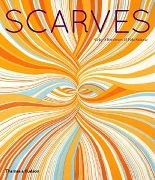Book review
Scarves
by Nicky Albrechtsen and Fola Solanke

|
Scarves by Nicky Albrechtsen and Fola Solanke Thames & Hudson (2011) 304 pages |
'The scarf is as important a part of the twentieth-century wardrobe as a pair of gloves or a handbag'. So begins Scarves, an impressively produced new book by costume and vintage experts Nicky Albrechtsen & Fola Solanke.
Compared to the attention lavished on other types of fashion accessories in recent years (in particular bags and shoes), scarves have been rather neglected, so I had high hopes that this book would redress the balance. Unfortunately, although Scarves will look great on your coffee table, this is not really the comprehensive survey that I had hoped for.
As it should, being published by Thames & Hudson, this book looks good - the hardback version has a slightly padded textile cover featuring a classic Richard Allan scarf from the 1960s. It's a weighty book, boasting 304 pages, with 257 illustrations (almost all in color), plus resources, further reading and notes for collectors.
But the first disappointment, for me at least, is that the vast majority of the book consists of full-page illustrations and so, despite the high page count, there is in fact very little text. Those hungry for information and analysis rather than pretty pictures will therefore be disappointed!
Moreover, despite the all-encompassing title of the book, the authors' focus is firmly on the 20th century square silk scarf, with an emphasis on the period from the 1940s to the 1980s. Scarves are even portrayed as an 'important innovation in 20th-century fashion', which is an interesting thought, but really far from true! (See my notes on the History of Scarves.)
In effect, Scarves is a picture book, and while the quality of the full color illustrations is high, the overall effect is strangely rather dull. Perhaps this is because the scarves are uniformly photographed square and flat, a single scarf to a page. There are almost no close-ups of design elements, and sadly none of the scarves are shown draped or folded. Therefore the swirls of color, the unexpected juxtapositions and peeks of pattern that give a sense of playfulness and life to scarves is almost completely missing. What a pity!
Having said that, there are some fine scarves pictured (as always, it's the Jacqmar designs that especially stand out for me), and those featured in the chapter on historic scarves are particularly memorable. Standouts include Jacqmar's celebrated 'London Wall' wartime propaganda scarf, an RAF 'escape map' (more on silk map scarves), a scarf commemorating 60 years of Queen Victoria's reign (1897) and an 'Olympic Scarf' of 1948 featuring the names of all the medal winners!
However, both in this chapter and others, the selection of scarves depicted feels rather random. With an almost infinite variety of scarves, why were these 250 or so selected? The authors give no information on what criteria they based their selection on, and there are no captions to explain special features of the scarves or why they are considered important or representative of a period or theme. Again, the book feels more like a designers' source book than a serious survey of scarves as fashion accessories and items reflecting social history.
The all too brief texts that accompany the illustrations are divided into a short introduction, followed by overviews to nine themed chapters, as follows:
The introduction and the earlier chapters are a little stilted, however the writers hit their stride in later chapters with brief but informative texts full of interesting facts and references. All the same, it's all a bit mechanical, and the reader never really feels any passion in the authors for their subject. There is obviously some detailed research behind this book - what a pity that more of it isn't shared with the reader.
On a happier note, the Resources section, although slim (a mere 14 pages, excluding the index) is both interesting and useful, with concise biographies of more than 50 major designers, couture houses and scarf companies, guides to scarf fabrics, the dating and authentication of vintage scarves, and their conservation and storage. Auction houses and dealers in vintage scarves are also covered, and there are suggestions for further reading.
Fundamentally this is an art book, a source book for designers and admirers of 20th century design, rather than a historical or social survey of the scarf as fashion accessory. So if you are a designer or an avid collector, then this is a book to add to your collection. If not, then - like me - you may wish to hold out for the definitive scarf book... a book yet to be written but already well overdue!
